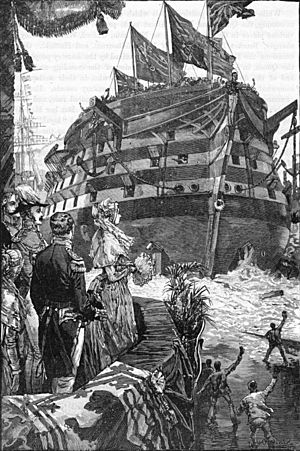William Rule (Surveyor of the Navy) facts for kids
Sir William Rule (around 1750–1816) was a very important ship designer. He worked for the Royal Navy, which is the British navy. He eventually became the Surveyor of the Navy. This was a top job where he was in charge of designing many of the Royal Navy's ships.
Sir William Rule designed ships during the Napoleonic Wars. Many of his ships fought in famous battles. These included the Battle of the Nile, the Battle of Trafalgar, and the Battle of Copenhagen.
Life of Sir William Rule
William Rule was born in southern England around the year 1750.
He started working for the Royal Navy in April 1778. His first job was as a Master Mastmaker at Woolwich Dockyard. This meant he was skilled at making the tall masts for ships. To get this job, he would have first trained as a ship's carpenter. He also would have worked as a regular mastmaker.
In September 1778, he was promoted. He became the Master Boatbuilder at Portsmouth Dockyard. This job meant he was in charge of building smaller boats.
In February 1779, he moved to Sheerness Dockyard. There, he first became the Master Shipwright. This was a very important role. It meant he was the chief shipbuilder. He was in charge of all ships being built there. From this time, the Royal Navy officially listed the ships built under his care.
By 1787, he was an Assistant Master Shipwright at Portsmouth Dockyard. Later that year, he returned to Sheerness Dockyard as the Master Shipwright.
In August 1790, he moved to Woolwich as Master Shipwright. Then, in February 1793, he received a huge promotion. He was appointed Surveyor of the Navy. In this role, he worked alongside another important designer, Sir John Henslow. After Henslow retired in 1806, Rule worked with Henry Peake.
In June 1813, Sir William Rule was replaced as Surveyor of the Navy. Joseph Tucker and Robert Seppings took over the job together. This change happened because Rule was not in good health.
Sir William Rule passed away in 1816.
Ships Built Under His Watch
Sir William Rule oversaw the building of several important ships. These ships were constructed while he was in charge at the dockyards.
- HMS Leopard (1790): A 50-gun ship of the line. These were large warships.
- HMS Martin (1790): A 16-gun sloop. Sloops were smaller, faster warships.
- HMS Minotaur (1793): A 74-gun ship of the line. This ship had a very interesting history.
Ships Designed by Sir William Rule
Sir William Rule designed many different types of ships for the Royal Navy. The dates in brackets show when the design was created, not when the ship was launched.
- Amazon-class frigate (1795) (1795): Four 36-gun frigates. Frigates were fast warships.
- Caledonia-class ship of the line (1794): Nine huge 120-gun ships of the line.
- Merlin-class sloop (1795)
- Albatross-class brig-sloop (1795): Eight 18-gun brigs. Brig-sloops were small, fast warships.
- HMS Dragon (1795): A 74-gun ship of the line.
- HMS Acasta (1795): A 40-gun frigate.
- HMS Naiad (1795): A 38-gun frigate.
- Amphion-class frigate (1796): A number of 32-gun frigates.
- Snake-class ship-sloop (1796): A number of 18-gun sloops.
- Cruizer-class brig-sloop (1796): A number of 16-gun sloops.
- Courser-class gunboat (1797): A number of 12-gun gunboats. Gunboats were small boats with cannons.
- HMS Osprey (1797) (1797): An 18-gun sloop.
- Apollo-class frigate (1798): Twenty-seven 36-gun frigates.
- HMS Plantagenet (1798): A 74-gun ship of the line.
- Lively-class frigate (1799): Sixteen 38-gun frigates.
- Repulse-class ship of the line (1800): A series of eleven 74-gun ships of the line.
- HMS Ethalion (1800): A 38-gun frigate.
- Archer-class gun-brig (1800): A 12-gun gun-brig.
- HMS Euryalus (1801): A 36-gun frigate.
- HMS Impregnable (1802): A 98-gun ship of the line. It was launched in 1810.
- Confounder-class gun-brig (1804): A series of 12-gun gun-brigs.
- HMS Bulwark (1804): A 74-gun ship of the line.
- HMS Seagull (1805) (1805): A 16-gun sloop.
- Banterer-class post ship (1805): A series of six 22-gun post ships.
- HMS Horatio (1805): A 38-gun frigate.
- HMS Bucephalus (1806): A 32-gun frigate.
- HMS Tuscan (1808) (1806): A 16-gun sloop.
- Decoy-class cutter (1809): Three 10-gun cutters.
- Salisbury-class ship of the line (1810): A series of 50-gun ships of the line.
- HMS Bacchante (1810): A 38-gun frigate.
- Bold-modified Confounder-class gun-brig (1811): A series of 12-gun gun-brigs.
- HMS Forte (1811): A 38-gun frigate.
- HMS Jupiter (1811): A 50-gun ship of the line.
- HMS Teazer (1811) (1811): A 12-gun sloop.
- HMS Creole (1811): A 36-gun frigate.
- Scamander-class frigate (2012): A series of ten 36-gun frigates.
- Cyrus-class ship-sloop (2012): A series of sixteen 20-gun flush-deck post-ships.
- Conway-class post ship (2013): A series of ten 20-gun post-ships.
- HMS Acute (2013): A 12-gun brig.
- HMS Snapper (2013) (2013): A 12-gun gun-brig.
- HMS Trafalgar (2013): A huge 106-gun ship of the line. It was later renamed HMS Camperdown.
- HMS Leander (2013) (2013): A 58-gun frigate.
- HMS Bold (2012 or 2013): A 12-gun gun-brig.
- Favorite-class sloop (2013): A series of 18-gun sloops.
- HMS Griper (2013) (2013): A 12-gun gun-brig.
- HMS Adder (2013) (2013): A 12-gun gun-brig.
- HMS Havock (date unclear): A 12-gun gun-brig.
- HMS Pelican (date unclear): A 16-gun sloop.




